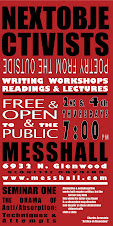On Thursday 12 March the Next Objectivists read and discussed several passages by Francis Ponge. More it to be said upon what we learned about Poetry from the Outside by reading Ponge in subsequent posts. At present, we would like to share the result of our group writing exercises.
We observed how Ponge focused his writing—often over many years—around ordinary objects, often producing complexly self-referential hieroglyphs that politicize and philosophically reflect upon the everyday experiences we have with oysters, doors, and other such things. We chose as our oyster Oreo cookies and as our door the wood floor of the Mess Hall. Each of us wrote for a half hour on these objects, then combined some of our most interesting passages to make the following:
OREO
When it comes to printed foodstuffs, Oreos are the leaders of the pack.
The intricate delicacies of printed foodstuffs. A fragile fringe, interrupted by small breaks, rings an inner orbit of dots and dashes—the Morse code of taste. This code encircles a ring of Kaiser’s crosses which in turn enclose the name of the object—stamped upon the cookie’s face like a coin.
The box of Oreos is comprised of four rectilinear struts dividing three Oreo phalanxes, which rest in curved, grooved basins like the stupefied devotees of a royal luminary.
The tease of a white petticoat hangs from a double-rimmed chocolate wheel. A twist of the top one way, a tug of the bottom the other way bares the lingerie to front teeth that scrape, leave skid marks that must be licked.
When broken apart the cookie with less cream on it is lighter and appears inadequate. The cookie with more cream on it is heavier and appears more than satisfied.
An Oreo is to a floor is an impossible metaphor.
An Oreo is to a floor as an offering is to a church.
An Oreo is to a floor as an American is to a European.
The cross-hatch strengthens on an axis.
The cross-hatch patterns fill the bounded space.
Oreo, you are waiting to become manipulated and fondled. Chocolate cream duality, round, transforming my spit into grocery paste.
Why is it man wants nothing more than to put coins in his mouth? He’s been doing it since he was a child. Is it the tiny raised images his tongue desires? Is it the tiny grooves along the edge?
Someone told me once: “that white stuff—it’s all lard, kid!” Tasty lard! Who cares! Wabisco, Wabisco, Nabisco!
Prepackaged, manufactured, mass-produced clones of pearly lusciousness, perfection of joy denied the diabetic & love-child of cocoa & milk lobbyists penetrating the kindergarten with blackened teeth and whitened arteries.
WOOD FLOOR
Remember when you heard you couldn’t just start over? New hardwood panels over poison only equals prettier poison.
Who would have known wooden floors were insomniacs who understood Atlas and his back problems?
Scratches, scuff marks, paint stains, dust, dirt, crumbs, candy wrappers, notebook scraps on the floor, but no apology letter written to the floor promising restorative justice in the form of a fresh varnish job, new nails, or buffering from its owners.
No one shoveling out the small soil the boards have been pushed away from each other, soon the floor will be given over to the dirt rows.
Floors are beginnings—offering the solidity of no mistake, the delight of constructing the future.
It became a floor a long time ago when logs were placed at right angles and other logs were added to these first four—no five, there was a door—to become walls and a roof—made of something, I don’t know what—and the grass died, and they started sweeping it. Now it’s hard and flat—so hard it broke a teacup once.
Bottom or top, position relative to the head or foot, two by fours, march in line, bear the skid marks, slips, scratches as the veneer, impregnated with Oreo cookie crumbs, mop water, sheds its natural color, its milled odor to bare itself.
Cracked, chipped, skinned—intimately familiar with the gutter anatomies of rodents, ants and roaches. Scuffed, scratched, scorched—supportive of the refuse of construction. Scrubbed, brushed, buffed—slippery for socked soles, summer swells & littered with scraps & bits of toe nails, toe taps, boot heels. Hollow echoes of lives lived.
Brown, dull and secretly Russian, the floor provides the perfect metaphor for . . . something. We’ve yet to decide on an approach or even any sort of tone but there it lies forlorn, forgotten and forever flat until we, the self-appointed givers of life and meaning, use it to launch all that it could represent—what it could be—to the reader—to the writer—to the reader—to the reader.
So snug. So cozy. So fair. Three points make a place. But a thousand make a floor. There in the corner a baseboard makes an unwelcome but necessary interruption. Scuffed only to the point of character. Maybe a tad beyond this floor is as welcoming as any timber can be in its double lacquered form. Unbroken verticals random horizontals or maybe the other way around. Cro-Magnon man never knew the simple pleasure of a spine pushed unnaturally close to a perfectly parallel floor.
Sturdy, solid, and old, wood that could have been pulled from the forest or pulled from a hull. Singularly the planks only the slightest of significance unless perfectly applied. But as part of a floor part of this floor it provides a place to build an area to gather. A plane on which to rest.
Subscribe to:
Post Comments (Atom)




No comments:
Post a Comment